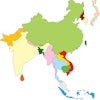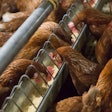"You are sitting on top of the No. 1 business in the world with fantastic and phenomenal growth," Matt Tripodi, Euromonitor International, told listeners at the USA Poultry & Egg Export Council winter meeting in Washington.
Tripodi was speaking of the market opportunity for U.S. poultry and egg producers in China.
In a word, he said, the opportunity for poultry is vast. Hundreds of millions of consumers will be attaining incomes in the next 10 years that allow them to purchase poultry.
"There is a tipping point in developing economies, about $5,000 disposable income, at which the consumption engine really cranks up. China is right about there. So we haven't seen the top of this market opportunity yet," he said.
China's vast market for poultry
How big is the market opportunity for poultry in China? The explosive growth of China's emerging middle class represents enormous economic demand as huge numbers of consumers become able to afford poultry. By 2022, more than 75 percent of China's urban consumers will earn CNY60,000 to CNY229,000 (US$9,896 to US$37,770) a year, according to McKinsey & Company estimates.
"As recently as 2000, only 4 percent of urban households in China were middle class; by 2012, that share had soared to over two-thirds. And by 2022, China's middle class should number 630 million - that is, three-quarters of urban Chinese households and 45 percent of the entire population. The rise of the middle class is essentially an urban phenomenon. Average per capita urban income in China is roughly triple that in the countryside, and there are set to be 170 million new urbanites between now and 2022," according to Dominic Barton, global managing director, McKinsey & Company.
China's poultry market today
China is the world's largest producer and consumer of eggs. To put the size of China's egg market in perspective, China produced an estimated 572 billion eggs in 2012, according to USDA's economic research service (ERS), while US egg production, including hatching eggs, was 93 billion.
The poultry and egg market for mainland China was estimated at $61.6 billion in 2012, and the Hong Kong market was estimated at $2 billion. China's domestic poultry industry won't be able to service the population's growing needs. China's importance as a trading partner, therefore, is only going to grow.
"China isn't just 'a' partner - it is 'the' partner in U.S. agricultural trade," Tripodi said.
"From 2011 to 2012, U.S. ag exports to China grew over $7 billion - unprecedented single‐year growth. From 2007 to 2012, China represented nearly 35 percent of total U.S. agricultural export growth. This is a whopping $17.7 billion out of $51.4 billion," he said. U.S. poultry and poultry products trade with China set another record to top $6.5 billion in 2013.
Positives for US egg exports to China
According to Euromonitor International, egg and egg products made up more than 62 percent of domestic poultry consumption in mainland China in 2012 and around 12 percent for Hong Kong. Poultry imports to Hong Kong in 2012 totaled more than $1.6 billion, and almost half of this was in eggs and egg products. US shell egg and egg product exports to China and Hong Kong have risen from $19.6 million in 2008 to $52.1 million in 2013 (Figure 2).
How can U.S. poultry producers continue to build their market share in China? Put the focus on market relevancy, Tripodi told listeners. U.S. poultry producers need to increase their relevancy up and down the supply chain to consumers, importers, and government officials. It is important to do so now because of the grab for shelf space going on in the marketplace. For shell eggs, Tripodi said that in China small white eggs do well in quick-service restaurants (QSR), large brown eggs for retail consumers, and large and extra large white eggs for high-end hotels and restaurants.
"China is an evolving marketplace that is becoming more sophisticated. Consumers there are concerned more and more about food safety. As a result, new legislation and regulation is coming online. This will make China a better marketplace for poultry. The net effect will be a more developed market which recognizes quality, and one in which U.S. poultry will compete on a more even footing," he said.


















